A packet is to be encapsulated inside an MPLS tunnel which consists of two MPLS headers at the first network egress. Which of the MPLS EXP fields will be marked?
Click the exhibit button below. Given the scheduler-policy (below), how much bandwidth can the best-effort traffic receive (PIR and CIR) when the ingress rate of each queue is 10Mbps?
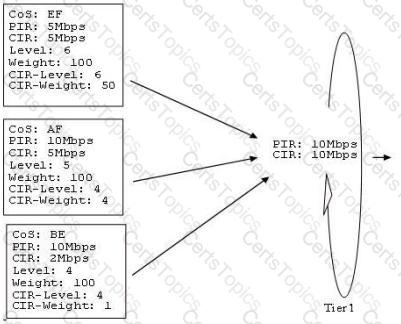
Click the exhibit button below. Given the SAP-ingress policy, which of the following statements are TRUE? (Choose three)
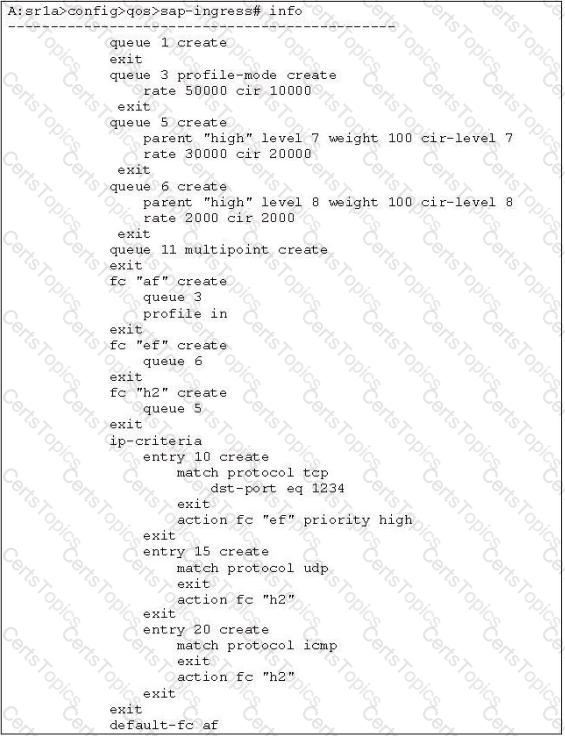
Which of the following fields in frames belonging to a Layer 3 service CANNOT be marked or remarked on SAP-egress?
Which of the following statements about G.8032 Ethernet Ring Protection is FALSE?
Which of the following is uniquely identified by the VPLS-ID in an LDP VPLS using Auto-Discovery^*
Which of the following rate-limiting approaches are used on the Alcatel-Lucent 7750 SR? (Choose two)
Traffic assigned to forwarding classes is placed into queues, while the contents of the queues are serviced in a controlled manner using____________.
According to the SAP-egress policy configured and applied, which queue will EF traffic use?
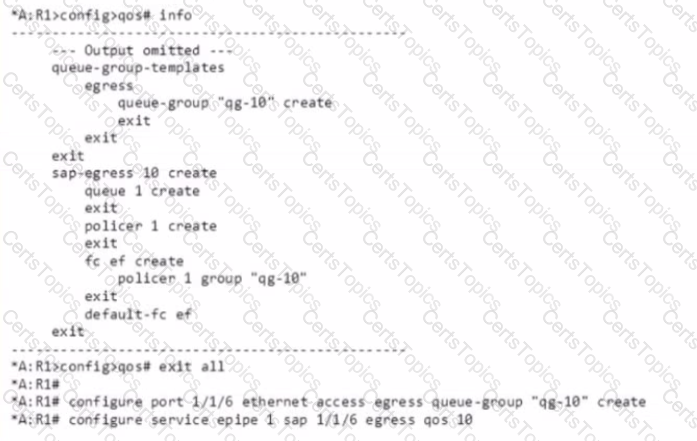
At which points can traffic be marked or remarked on the Alcatel-Lucent 7750? (Choose two)
Which of the following is a feature of LDP VPLS?
Which of the following is NOT one of the four elements in the Nokia 7750 SR QoS solution'
When deploying an Alcatel-Lucent MPLS network with QoS, how are the EXP bits set?
If packets egressing a SAP do not match any criteria defined in the SAP-egress policy, which forwarding class will these packets be assigned to?
Individual application streams are considered microflows, whereas __________ are considered macroflows.
Which of the following statements about a Management VPLS is FALSE?
According to the SAP-ingress QoS policy shown, what needs to be the depth of the CIR bucket of policer 5, as a minimum, for forwarded packets to start being marked as out-of-profile?
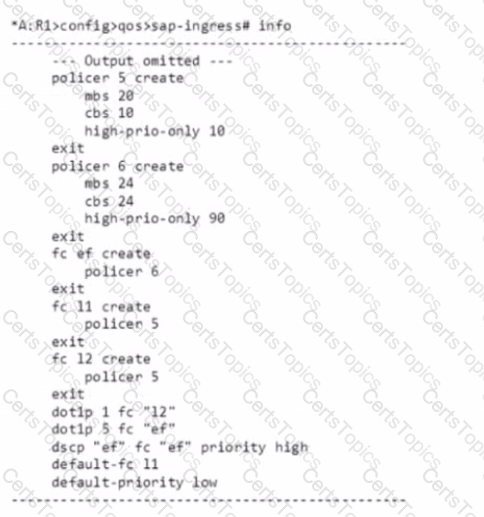
In which of the following scenarios is self-generated traffic QoS (sgt-QoS) useful?
By default, how does a hybrid port on a Nokia 7750 SR share its allocated buffer space between access and network pools?
Which of the following parameters are used in a hierarchical scheduler-policy to specify the priority of the child scheduler/queue for allocating bandwidth beyond its committed rate? (Choose two)
Which of the following statements BEST describes an MBS parameter?
Without_______, a customer's high priority traffic can be dropped before its low priority traffic.
Click the exhibit button below. Each router is interconnected by a single GigE link, as shown in the diagram below.
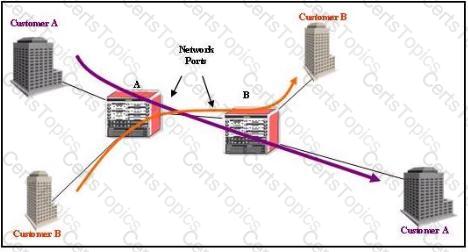
Note: The arrows show the direction of traffic flow.
Traffic from Customer A and Customer B that is classified to the same forwarding class is queued together at the ingress of Router B.
On the Alcatel-Lucent 7750 SR, what is the maximum number of queues that a single SAP-ingress policy can support in a VPLS?
Click the exhibit.
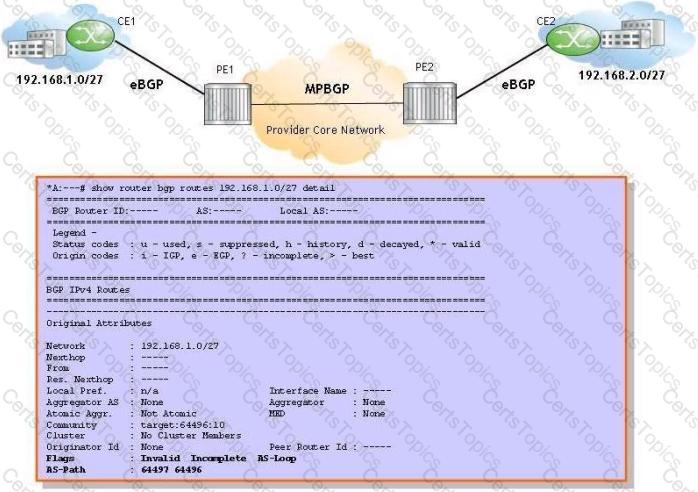
According to the display, a BGP loop is detected for route 192.168.1.0/27. On which router is this command executed?
Which of the following is a benefit of a hub and spoke VPRN topology?
Which of the following about inter-AS model A VPRN is FALSE?
Based on the VPRN BGP decision process, which of the following routes is selected first?
Based on the VPRN BGP decision process, which of the following routes is selected first?
How was standard BGP modified to allow it to carry routing information for VPRNs?
Click the exhibit.

A Carrier Supporting Carrier (CSC) VPRN is configured for a customer carrier who is an Internet Service Provider (ISP). Which route is NOT present in PE1's global routing table?
Click the exhibit.

A Carrier Supporting Carrier (CSC) VPRN is configured on an Alcatel-Lucent 7750 SR for a customer carrier who is an Internet Service Provider (ISP). Which of the following configuration steps is NOT required?
Which of the following about inter-AS model B VPRN is TRUE?
What are the two primary problems the service provider must consider when providing traditional Layer 3 VPN services using only a single common routing table in the provider core? (Choose two)
Click the exhibit.
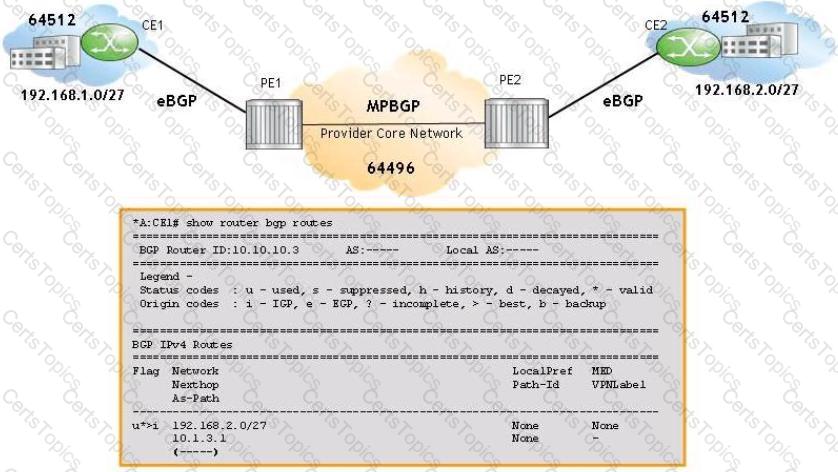
The CLI command "remove-private" is configured on PE1 to eliminate BGP loops in the VPRN. For the displayed route, what is the value of the AS-Path field?
Click the exhibit.

For the inter-AS model B VPRN, which of the following protocols is used to advertise routes between PE1 and ASBRI?
Which of the following about inter-AS model B VPRN is FALSE?
Click the exhibit.
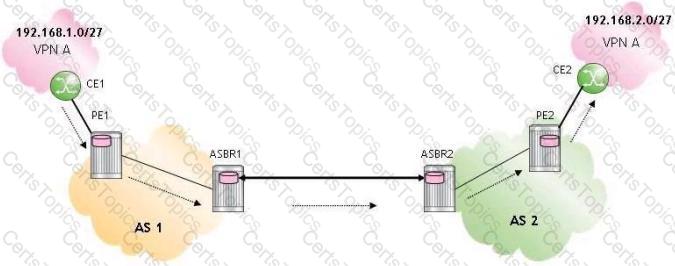
For the inter-AS model A VPRN. BGP is used as the PE-CE routing protocol. Which of the following statements about the control plane operation is TRUE?
Click the exhibit.
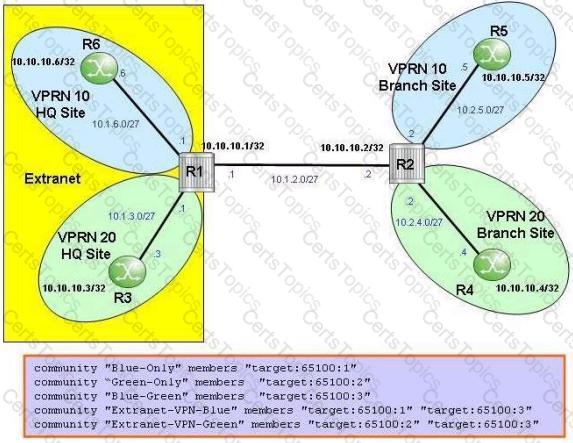
The headquarter sites of VPRN 10 and VPRN 20 ate part of an extranet VPRN. Which of the following communities are included in the export policy applied to VPRN 10 on router R1?
Which command may be used on an Alcatel-Lucent 7750 SR to verify the number of VRF routes allowed, based on the maximum routes value configured in the service instance?
Which of the following about BGP Site of Origin (SoO) is FALSE?
Given the following VPRN topology: The VPRN service 10 is correctly configured and operational with OSPF as the PE to CE routing protocol at both customer sites. The OSPF database on CE-A contains Type 1 LSAs. These routes will appear as what LSA type on CE-B?

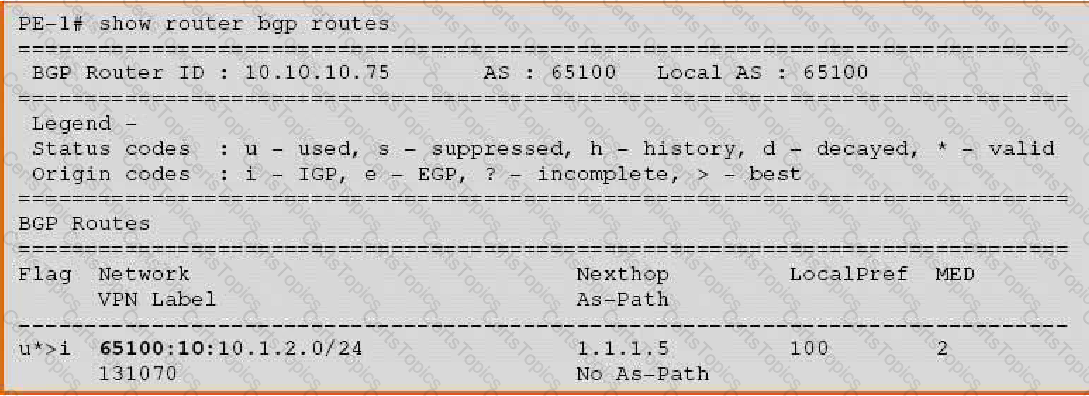
Click the exhibit.
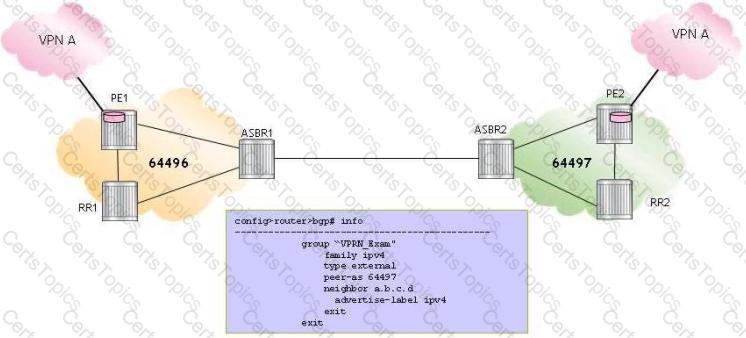
For the inter-AS model C VPRN, which router is configured as shown?
Click the exhibit.
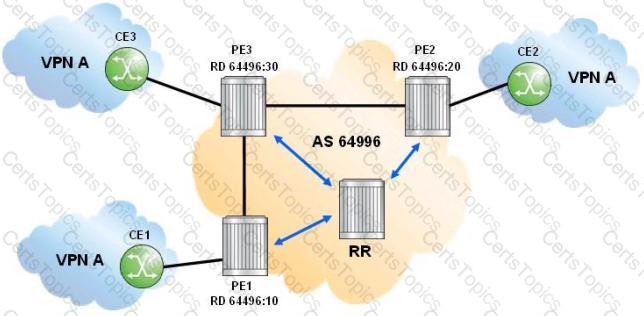
One Route Distinguisher is assigned per VRF. If CE1 and CE2 advertise prefix 10.1.1.0/24, which of the following statements is FALSE?
Which of the following terms also correctly describes a Layer 3 VPN?(Choose three)
Click the exhibit.
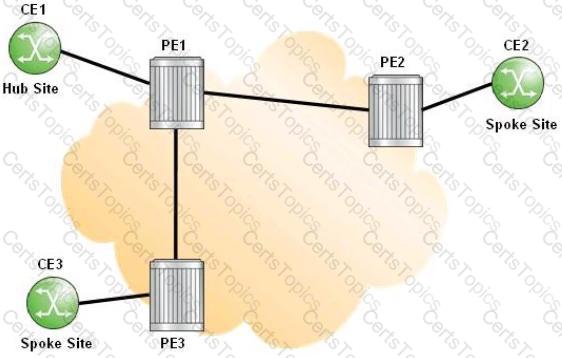
For the CE hub and spoke VPRN, which of the following is FALSE?
Which protocol is used to exchange customer VPRN routes between PE devices?
Assuming that as-override has been used, which of the following statements describes the most likely location of prefix 10.1.2.0/24, based on the output from an Alcatel-Lucent 7750 SR shown below?
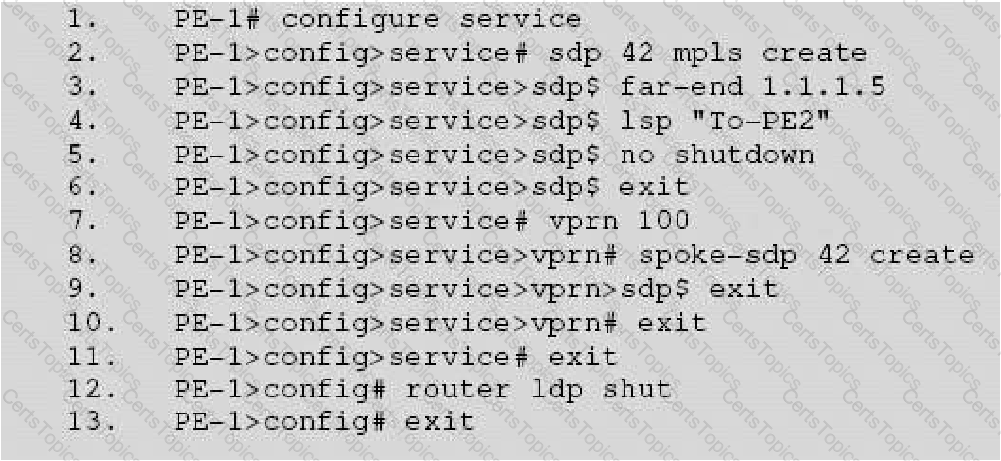
The user of an Alcatel-Lucent 7750 SR wants to see the effect of changing an import policy immediately. What is the best command to force re-evaluation of the import policy with minimal impact?
Which of the following prefix lists include prefixes 192.168.128.0/17 and 192.168.64.0/18?
When an Alcatel-Lucent 7750 SR receives a BGP route with an AS Path loop, what action is taken by default?
Click the exhibit.
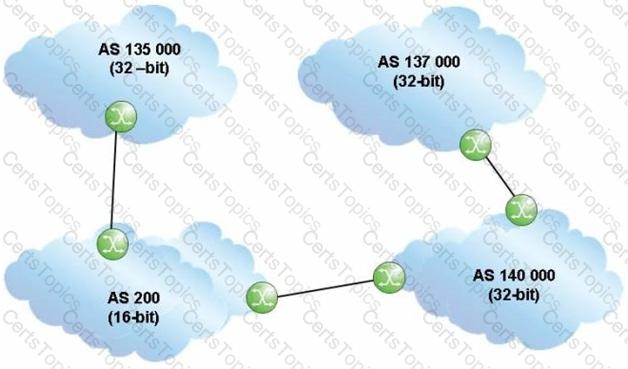
An update travels from AS 137000 to AS 135000, traversing both 32-bit and 16-bit AS Paths.
What AS Path is seen by AS 200?
Assuming that "client1" and "client2" are directly-connected networks, what is the result of executing the following BGP export policy?
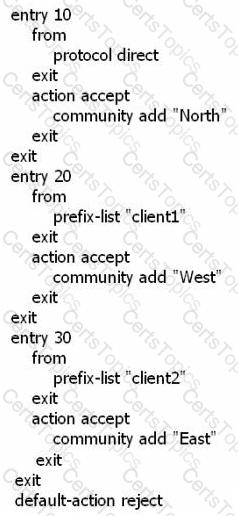
Which of the following describes BGP route processing on the Alcatel-Lucent 7750 SR?
The following policies are configured and exported using "export "Policy-1" "Policy-2"". Assuming both "Client-1" and "Client-2" are properly defined on the router, which routes are advertised?
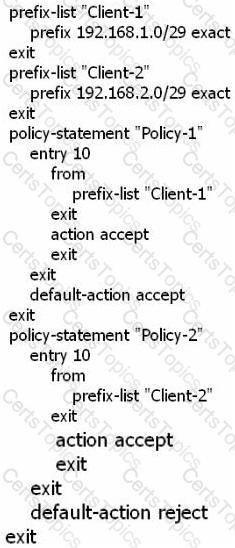
A confederated AS is comprised of three members. One member is comprised of 4 routers, while the other two members are comprised of 3 routers each. Assuming member ASs are fully meshed and use full mesh iBGP, what is the required number of BGP sessions within the confederation?
From what range are 16-bit private AS numbers selected?
Click the exhibit.
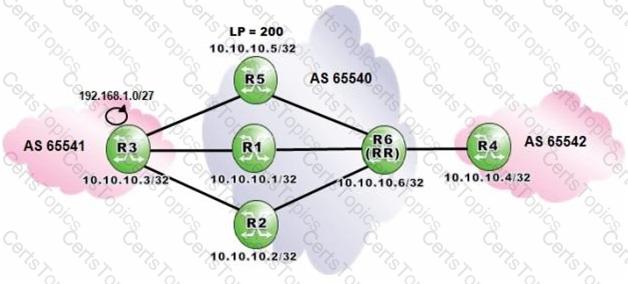
Router R6 is a route reflector for clients R1, R2 and R5. Router R5 is configured with a local preference of 200. On which routers is "advertise-external* needed for router R6 to receive exactly two distinct routes for prefix 192.168.1.0/27?
Router R1, in AS 65540, has the export policy shown below. It advertises an aggregate route to eBGP peer router R2 in 65550. What is the AS Path of the aggregate route received by router R2?
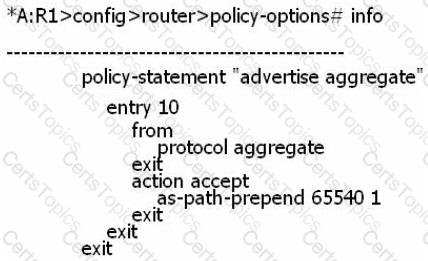
What class of attribute is Originator_ID?
Based on the default settings for the Alcatel-Lucent 7750 SR, when a policy change is made and committed, what action is required by the user for the change to take effect?
Which of the following regarding the withdrawal of routes from one BGP speaker to another is
TRUE?
Which of the following prefix-lists is the most specific match for prefix 172.31.2.1/24?
Assuming that "client1" and "client2" are directly-connected networks, what is the result of executing the following BGP export policy?
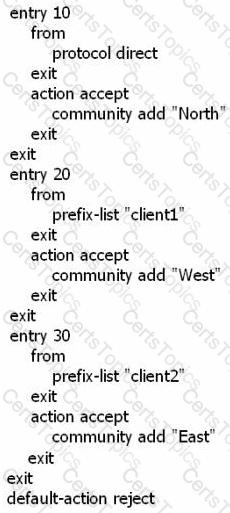
What is the purpose of configuring a triggered-policy on an Alcatel-Lucent 7750 SR?
Click the exhibit.
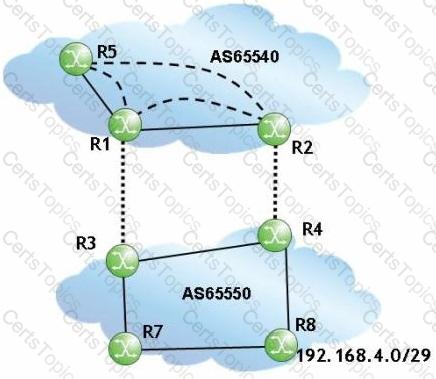
Router R2 receives a route to 192.168.4.0/29 from router R4 and sets the local preference to 110.
Router R1 receives the route to 192.168.4.0/29 from router R3, and sets the local preference to
80. There is a full iBGP mesh in AS 65540, but router R5 only has a physical connection to router R1. Which path does traffic destined to 192.168.4.0/29 take from router R5?
Which of the following statements regarding Internet Exchange Points is FALSE?
Click the exhibit.
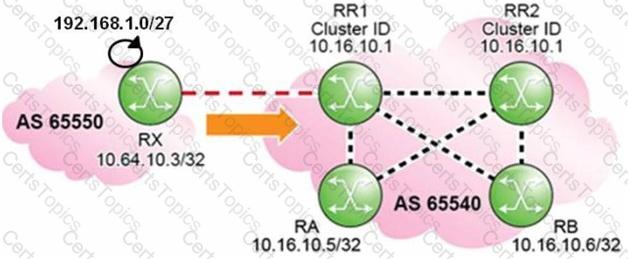
Routers RR1 and RR2 are route reflectors with the same cluster-ID. How many updates for prefix 192.168.1.0/27 are received at router RR1?
How is the aggregator attribute handled with 32-bit AS numbers?
Which of the following is NOT considered an option of import policies?
What kind of BGP attribute is the Multi_Exit_Disc?
Click on the exhibit.

AS 65540 is using MPLS to provide BGP shortcuts for its iBGP routing. Which routers must be configured with the "configure router bgp igp-shortcuts rsvp-te" command?
IEEE 802.3ah is similar to SONET/SDH in that it can count and report bit errors and frame errors.
An l-VPLS is configured with a service id of 511. What will the value of the l-SID be assuming a default configuration?
Consider a large metro-to-metro VPLS network interconnected with a mesh of mesh-SDPs. Which of the following statements does NOT apply to this situation?
What is the SA in the Ethernet frame used for by a layer 2 switch?
Click on the exhibit below.
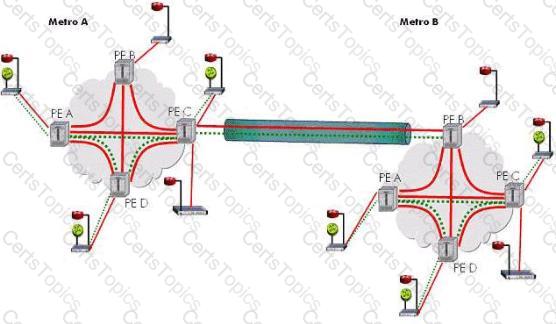
Assuming there is a full mesh of mesh-SDPs between the PEs within each metro network and a spoke-SDP between PE-C of Metro A and PE-B of Metro B. how is traffic forwarded from PE-A in Metro A to PE-D of Metro B? Select the most accurate statement.
How does PBB forward broadcast, unknown-unicast and multicast traffic from a B-VPLS to an l-VPLS?
Click on the exhibit below.
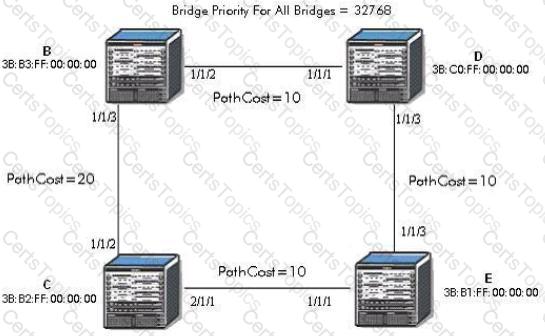
Which ports will become root ports? (Choose 3)
Which of the following is a true statement?
How is the Primary Bridge chosen in a VPLS?
Click on the exhibit below.

In the diagram below, SAP 1 is put into the blocking state as a result of the spanning tree protocol. What will occur in the VPLS instance if SAP 2 goes down and SAP 1 transitions to the forwarding state? Select the most accurate statement.
When ports configured with IEEE 802.3ah EFM are operationally down, what must the device do before declaring the ports are up?
Which of the following needs to be considered when designing Ethernet networks with redundancy?
Click on the exhibit below.

The MDU attached to this PE has been configured with active/standby SDP's configuration option has been configured for the PE to recognize that this SDP is in standby mode?
Which of the following statements relating to VPLS is false?
Click on the exhibit below.
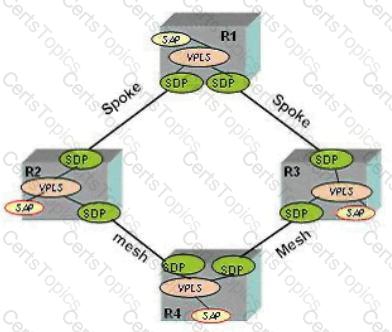
If the SDP between R2 and R1 goes down, what devices will be reachable from R2 through the VPLS?
Which of the following describes the scope of the IEEE 802.3ah EFM standard? (Choose 3)
Which of the following is NOT a feature of the IEEE 802.3ah EFM standard?
In RSTP, how is the root bridge selected?
What is the MTU impact on the SDP path-mtu if fast reroute, one-to-one mode is implemented on the LSP?
A customer has requested a VPLS service. The customer is using dot1q encapsulation and they have requested that all vlan tags be transparently passed. Which two SAP IDs will accept VLAN tags and pass them transparently? (Choose 2)
Click on the exhibit below.
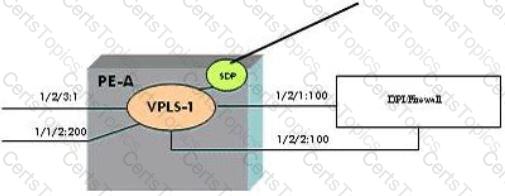
In the following diagram, traffic ingressing on SAP 1/2/3:1 will be passed to the layer-2 DPI device for inspection based on a filter policy applied to the ingress of the SAP. What feature should be enabled on SAP 1/2/1:100 and SAP 1/2/2:100 to ensure that incorrect information is not populated in the FDB of VPLS 1?
Click on the exhibit below.
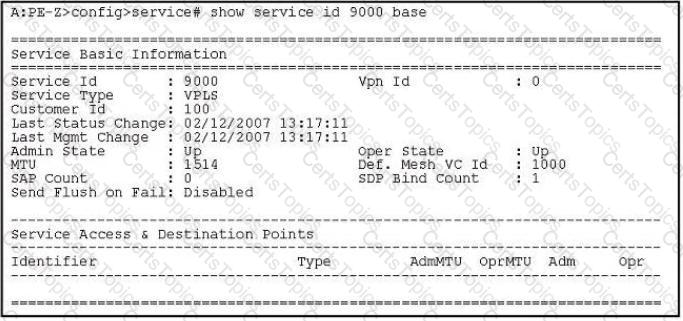
Based on the following output what will the vc-id be of any mesh-sdp bound to this service?
Click on the exhibit below.
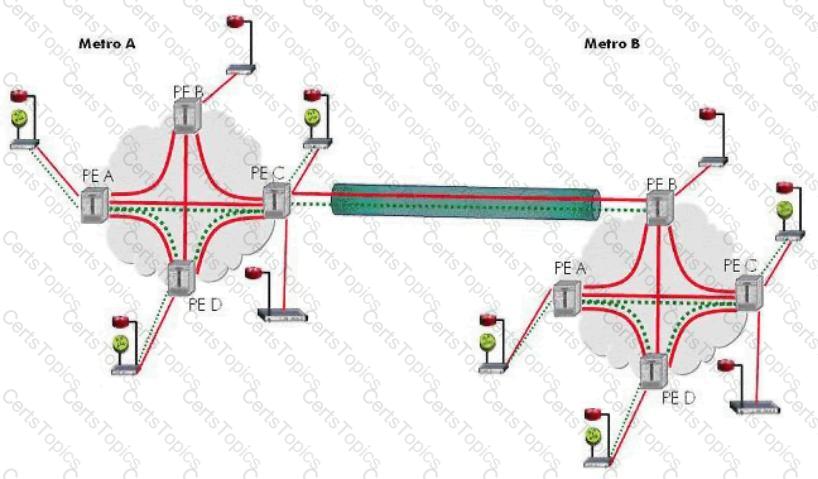
How many LSPs are required in total between Metro A and Metro B if 100 hierarchical VPLS services are deployed across the two metro networks?